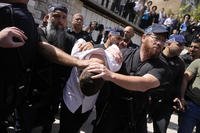The stand-off with Iran over its nuclear ambitions was just beginning while I was embedded with Marine All-Weather Fighter Attack Squadron 332 at Al Asad air base in Iraq. More than once the fliers lamented that they'd probably be back in the States by the time the "inevitable" bombing of Iran got underway. One conversation went something like this:
Me: Oh God. We can't afford a war with Iran
Aviator #1: Whatever. We'd kick their asses.
Aviator #2: No, they've got F-14s!
Aviator #3: Yeah, my wife [deployed to northern Iraq] saw one!
Aviator #1: We'd still kick their asses.
Me: Oh God.
 If, God help us, the stand-off does turn violent, U.S. air power will play a critical role. For months pundits have predicted a massive bombing campaign to target Iran's nuclear facilities, and perhaps even to attempt regime change.
If, God help us, the stand-off does turn violent, U.S. air power will play a critical role. For months pundits have predicted a massive bombing campaign to target Iran's nuclear facilities, and perhaps even to attempt regime change.But don't expect Iran's air force to roll over like Iraq's did in 1991 and again in 2003. Unlike the Iraqi air force, the Islamic Republic of Iran Air Force (IRIAF) appears to be well-armed, well-trained and eager for a fight. Besides the aforementioned F-14 Tomcats, 79 of which the U.S. sold to the country before the Shah was deposed, the air force operates several dozen of each of the following types:
J-7 (Chinese-built MiG-21 derivative)
MiG-29
Su-24
F-5E
F-4E Phantom
Mirage F1
All told, the IRIAF flies as many as 300 fighters. All are older designs, but have been maintained and, in many cases, upgraded by the indigenous aerospace industry, which has become proficient in reverse-engineering weapons and spare parts -- and perhaps even engines. And the IRIAF has aerial tankers too -- a force multiplier only the most advanced air forces maintain.
Veteran aviation correspondent Tom Cooper and his co-writer Liam Devlin wrote a fascinating feature for a recent issue of Combat Aircraft Magazine, profiling the IRIAF. The authors interviewed IRIAF defectors and U.S. Navy aircrew that have tangled with Iranian fliers over the Arabian Gulf. The feature cautions against the Western habit of underestimating the IRIAF:
In November 2003, a USAF E-3 Sentry flying a patrol over Iraq tracked a formation of no less than 16 IRIAF F-14As ... This was the largest group of Iranian F-14s detected in flight by the U.S. military since 1997, when nine IRIAF Tomcats were tracked over the southern Persian Gulf by the U.S. Navy. ... During the summer of 2005, several Su-24s were observed operating over the Persian Gulf, armed with Chinese-made C802K-2 anti-ship missiles. ... Iranian Phantoms were sighted as well, usually carrying AIM-7 Sparrow and AIM-9 Sidewinder [air-to-air missiles].
Now that the 1st Fighter Wing has its first F-22 squadron combat-ready, and with the Navy's Super Hornets equipped with electronically-scanned radars, we have the capability to beat the IRIAF. But it wouldn't necessarily be an easy fight. Throw in Iran's SA-15 surface-to-air missiles and you've got a tough air-defense nut to crack. And remember ... an air campaign might be just a prelude to a ground invasion. Last year I stood on the Iraq-Iran border and listened to Iranian armored divisions throw down practice artillery barrages. The Tennessee National Guardsmen I was with (the 278th cavalry regiment equipped with M-1 Abrams tanks) admitted that they couldn't punch through that border if they wanted to.
We must find a diplomatic solution to the problem of Iran's nuclear ambitions.
--David Axe
P.S. -- This discussion of Cooper's article includes some interesting insights.








